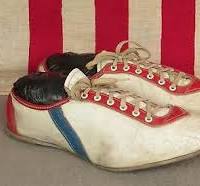Although I’ve done some running over the years – some Spartan races, a 5K or two – I am by no means a serious runner. Still, I do have a lot of admiration for runners – especially distance runners – and read with great interest a fascinating article by Jonathan Rosen on the latest high tech running shoes, an article that appeared in the MIT Technology Review this past June.
The article centered on runners from Kenya, and that’s no surprise. As Rosen notes, “Kenya-born athletes accounted for 28 of the event’s all-time 50 fastest men and 17 of its 50 fastest women.” The official marathon record (2:00:35) was set by Kelvin Kiptum last October, and the unofficial record – and only sub-two-hour marathon – was set by Kiptum’s fellow countryman Eliud Kipchoge in 2019. (Time 1:59:40.2.) Kiptum was hoping to run a sub-two-hour race when, sadly, he was killed in an accident last winter.
Kenyans have achieved their stunning success for a number of reasons. The tribes that make up the majority of the country’s top runners share physical characteristics that make for an “energy-efficient gate.” These characteristics include “thin lower legs, long Achilles tendons, and a high ratio of leg length to torso.” Kenyan children are very active – they run places – and they’re running at high altitudes that “help boost aerobic capacity.” Then there are the financial drivers. While Kenya is more industrialized and prosperous than many other African nations, many people live in poverty, and running is viewed as a way out.
But one key to the record shattering is the “supershoes” that competitive runners – and not just those from Kenya, of course – are wearing.
It was interesting to read that running shoe “technology” changed little between 1908 (when rubber heels made their Olympic debut) and 1975 when ethylene vinyl acetate (EVA), and “air-infused foam” made running shoes that were lighter and bouncier. And for decades after, most running shoe improvements were for the most part EVA tweaks. And then, in 2017, Nike introduced the Vaporfly, which had a curved carbon-fiber plate and “a thick midsole material made from a foamed polymer known as polyether block amide, or PEBA.” That’s what puts the pep in a runner’s step (and helps runners suffer fewer injuries and recover more quickly from a grueling race).
after, most running shoe improvements were for the most part EVA tweaks. And then, in 2017, Nike introduced the Vaporfly, which had a curved carbon-fiber plate and “a thick midsole material made from a foamed polymer known as polyether block amide, or PEBA.” That’s what puts the pep in a runner’s step (and helps runners suffer fewer injuries and recover more quickly from a grueling race).
And since 2017, this has been the name of the supershoe game.
The most crucial feature is the (often proprietary) foams that are used to construct parts of the sole. These absorb the impact of the foot and return energy from each foot strike back to the runner. Some use other features, like the orange “air pod” in the Nike Alphafly 3, for an added bounce.
Bounciness alone would not provide much advantage—today’s foams are so soft and thick (World Athletics allows up to 40 millimeters in competitions) that without additional support they would make the feet highly unstable. To give the shoes structure, manufacturers add rigid components like carbon-fiber plates or rods, typically sandwiched between layers of foam.
These rigid parts and foams are combined with wafer-thin mesh uppers to create shoes that are increasingly ultralight: the Adidas Adizero Adios Pro Evo 1, released in 2023, weighs just 4.9 ounces (measured in the men’s size 9). Lighter shoes also reduce the energy expended with each stride—enabling runners to move at a given pace with less effort. The Adidas Adizero Adios Pro Evo 1 was designed to be worn just once.
Interestingly, there’s research “that some runners get a greater boost from the technology than others, depending on their biomechanics.” And even those who are most in favor of supershoes (not everyone is) don’t want to take away the from the “talent, training, drive, and mental toughness” of the world’s most successful runners. Training has also improved over the years, and “new hydrogel-based sports drinks…make it possible to digest more calories during races.” (Kiptum’s coach had “estimated that the shoes improved Kiptum’s marathon time by a minute, or perhaps a little more.” Which is, of course, pretty significant, especially in the major races with large purses where split-second timing can translate into tens of thousands of dollars.)
As for Kenyan runners, the supershoes are to some degree a mixed blessing. For the top runners, it makes a performance difference. For those trying to make their mark, it works against those who can’t afford them.
Anyway, even though I’m not that much of a runner, and running shoe technology isn’t the sort of technology I’m involved with, I found the story about supershoes a fascinating one.
